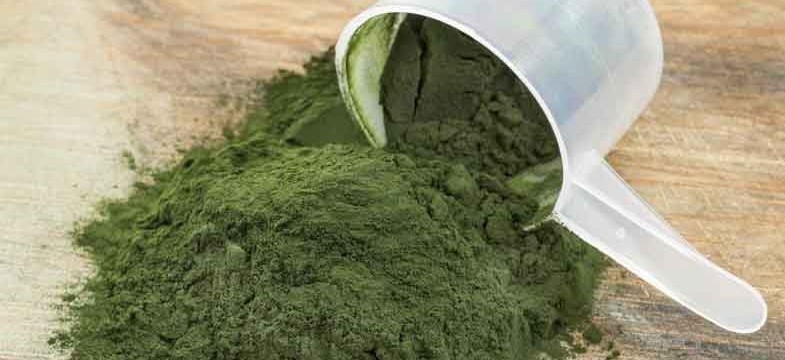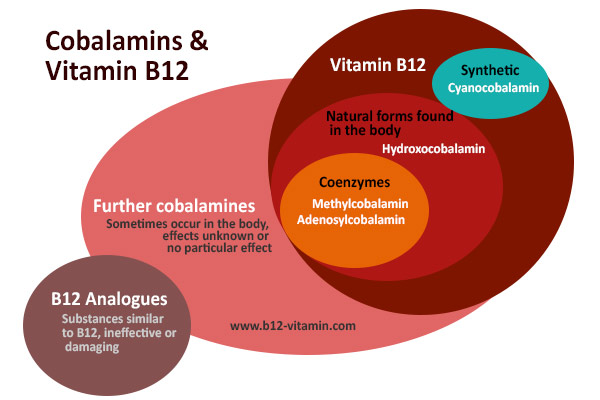Contents
|
Vitamin B12 and B12 Analogues
Vitamin B12 analogues or pseudo vitamin B12 are molecules that are very similar to vitamin B12 in their chemical structure, but which cannot be utilised by the body. Moreover, they do not contain any of the health benefits of vitamin B12 and can even be harmful to health; they occupy important transport molecules and thus inhibit the intake of genuine B12.
When researchers began studying vitamin B12, they could not distinguish the real vitamin from the analogues, since the tests they used measured both forms. Today, however, paper chromatography has been used to clearly identify analogues in many B12 food source. As a result, many foods that used to be considered rich in the vitamin unfortunately turned out to only contain B12 analogues.
Vitamin B12 Analogues and Plant Sources of B12
For vegetarians and vegans this is particularly bad news, as many plant foods that were used previously as vitamin B12 sources instead of supplements in fact contain analogues. As of yet, unfortunately no plant sources of B12 have been verified. Those which allegedly contained the vitamin but which are now suspected/proven to contain vitamin B12 analogues include, for example:
- Spirulina (1)
- Nori (2)
- Miso (3)
- Wakame (4)
Some of these are still marketed as sources, however tests have shown that they can often even worsen vitamin B12 deficiency (5).
For more information, see our article: Vitamin B12 and Algae
What are Vitamin B12 Analogues?
Vitamin B12 (cobalamin) is a very large molecule, which is always bound to another molecule group in the body. The different forms of vitamin B12 are thus distinguished according to which molecule the cobalamin is bound to: methylcobalamin is cobalamin with a methyl group; cyanocobalamin is cobalamin with a cyano group.
Vitamin B12 functions biologically like a coenzyme, which enables the work of other enzymes. There are however only two specific forms of B12 that are active as such a coenzyme in the body:
- Methlycobalamin
- Adenosylcobalamin
Two further cobalamines can be converted in the body into these forms: cyanocobalamin and hydroxocobalamin. These two forms are not directly active, yet useful precursors of the active coenzymes.
In addition to these there are also more cobalamins, which the body cannot use. In turn, all of these cobalamines belong to the yet larger molecule group of the corrinoids – molecules that like vitamin B12 have a cobalt atom at the centre.
Some of these corrinoids have a very similar chemical structure to vitamin B12, yet have no function in the body and in contrast are even damaging (6).
Vitamin B12 Analogues: Not Only Useless, but Harmful too
Vitamin B12 analogues resemble the real vitamin so much that not only tests but even the body confuses the two. Pseudo-vitamin B12 binds to precisely those transport molecules that are responsible for the circulation of B12, putting them in direct competition with each other.
Since the capacity of the transport molecule is limited, the analogues occupy places intended for B12. As a result, it becomes harder for the body to absorb the real vitamin. The more analogues we take in, the worse our body utilises real vitamin B12.
Various studies have shown that analogues bind to all known transport molecules – thus also intrinsic factor (IF), which is primarily responsible for the intake of B12 from the diet and found on the corresponding receptors on the intestinal wall (7). B12 analogues are therefore not only ineffectual but damaging too.
Also in the blood, conventional serum tests cannot distinguish between some analogues and the real B12. A deficiency can therefore occur when serum values appear to be very high. Consequently, other test are increasingly used today, such as the MMA urine test (8, 9).
Vitamin B12 and its Analogues: Hard to Distinguish
To measure the vitamin B12 content in a sample, different methods have been developed. Nonetheless, almost all of them cannot distinguish between B12 and its analogues.
Method | Function | Risk of Confusing B12 with Analogues |
Microbiological test | Measures levels of microorganisms whose growth depends on B12 | High |
R-protein test | Determines amount of B12 that binds to R-protein | High |
Intrinsic factor test | Determines amount of B12 bound to intrinsic factor | Lower, but still possible |
Radioisotope dilution assay (RIDA) | = intrinsic factor test | Lower, but still possible |
Paper chromatography | Molecular structure analysis | Analogues can be identified, but only molecule by molecule |
It is clear to see that only paper chromatography, which directly examines the molecules, can definitively distinguish between B12 and analogues.
Vitamin B12 Blood Test and Analogues
Since the B12 serum test is also based on an IF test, it also measures some B12 analogues and thus does not provide reliable information about the proportion of biologically-usable B12.
In order to determine a deficiency and also to verify the B12 content in foods, today there is an increasing trend not to measure the vitamin directly, but certain metabolic products. This provides reliable information about the actual B12 activity in the body. The best option here is the MMA urine test: only if a certain food successfully lowers the MMA level can it be concluded to contain usable vitamin B12.
More on this topic: Vitamin B12 Urine Test
Vegan Vitamin B12 Sources and Pseudo B12
Knowledge of analogues is particularly important for the discussion of vegan B12 sources. Almost all supposed plant sources of the vitamin have transpired to be sources of analogues instead.
Interesting results are also obtained from algae, which show that the fresh plant contains real B12, while the dried plant contains analogues only (2). The process of drying the plant seem to lead to chemical reactions which decompose the vitamin content.
Since it is not the plant itself but resident microorganisms that produce B12, the ratio of B12 to analogues varies extremely depending on which bacteria live in the plant’s growing environment. This can even vary from year to year and is the reason why different studies arrive at such contrasting results. For example, some studies have found that chlorella algae have quite high levels of B12 (10), while others have found it to have no content at all (11).
To date, no plant source has been found that reliably lowers the MMA level, however, there is a lack of corresponding studies to compare plants according to their different cultivation areas. Still, there remains no recognised plant source of B12. In contrast, some researchers even warn against using algae as a source of the vitamin, since the analogues may even inhibit a genuine supply.
Currently, only chlorella, aphanizomenon flos-aquae, dulse and coccolithophorid algae are being investigated as possible sources of real B12. In all others, analogues predominate, so that they can even have negative effects.
The most promising candidate to date remains chlorella, for which all recent studies have found quite high B12 levels.
Sources
1. Watanabe F, Katsura H, Takenaka S, Fujita T, Abe K, Tamura Y, Nakatsuka T, Nakano Y. Pseudovitamin B(12) is the predominant cobamide of an algal health food, spirulina tablets. J Agric Food Chem. 1999 Nov;47(11):4736-41.
2. Yamada K, Yamada Y, Fukuda M, Yamada S. Bioavailability of dried asakusanori (porphyra tenera) as a source of Cobalamin (Vitamin B12). Int J Vitam Nutr Res. 1999 Nov;69(6):412-8
3. Treuesdell, D. D., Green, N. R. and Acosta, P. B. (1987), Vitamin B12 Activity in Miso and Tempeh. Journal of Food Science, 52: 493–494. doi: 10.1111/j.1365-2621.1987.tb06650.x
4. Yamada S, Shibata Y, Takayama M, Narita Y, Sugawara K, Fukuda M. Content and characteristics of vitamin B12 in some seaweeds. J Nutr Sci Vitaminol (Tokyo). 1996 Dec;42(6):497-505.
5. Dagnelie PC, van Staveren WA, van den Berg H. Vitamin B-12 from algae appears not to be bioavailable. Am J Clin Nutr. 1991;53:695-7.
6. Carmel R, Karnaze DS, Weiner JM. Neurologic abnormalities in cobalamin deficiency are associated with higher cobalamin ‘analogue’ values than are hematologic abnormalities. J Lab Clin Med. 1988 Jan;111(1):57-62
7. Bunge MB, Schilling RF. Intrinsic factor studies. VI. Competition for vit. B12 binding sites offered by analogues of the vitamin. Proc Soc Exp Biol Med. 1957 Dec;96(3):587-92. PubMed PMID: 13505799.
8. Murphy, M. F., Sourial, N. A., Burman, J. F., Doyle, D. V., Tabaqchali, S. and Mollin, D. L. (1986), Megaloblastic anaemia due to vitamin B12 deficiency caused by small intestinal bacterial overgrowth: possible role of vitamin B12 analogues. British Journal of Haematology, 62: 7–12. doi: 10.1111/j.1365-2141.1986.tb02894.x
9. J. Fred Kolhouse, M.D., Haruki Kondo, M.D., Nancy C. Allen, R.N., Elaine Podell, A.B., and Robert H. Allen, M.D. „Cobalamin Analogues Are Present in Human Plasma and Can Mask Cobalamin Deficiency because Current Radioisotope Dilution Assays Are Not Specific for True Cobalamin“ N Engl J Med 1978; 299:785-792October 12, 1978DOI: 10.1056/NEJM197810122991501
10. Kittaka-Katsura H, Fujita T, Watanabe F, Nakano Y. Purification and characterization of a corrinoid compound from Chlorella tablets as an algal health food. J Agric Food Chem. 2002 Aug 14;50(17):4994-7
11. Pratt R, Johnson E. Deficiency of vitamin B12 in Chlorella. J Pharm Sci. 1968 Jun;57(6):1040-1



